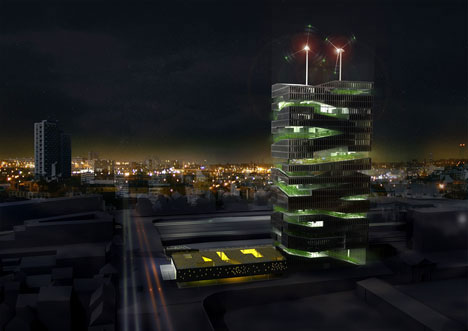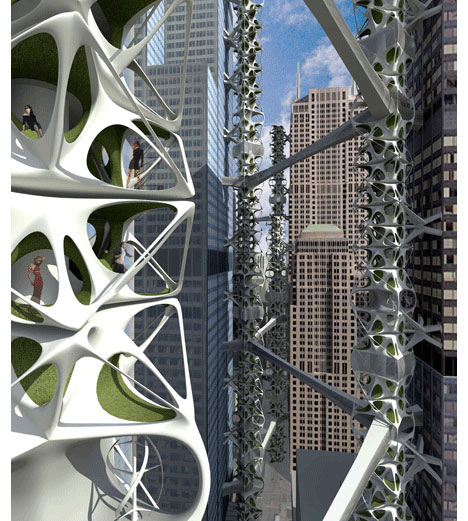
Tuesday, 13 May 2008
Thursday, 8 May 2008
Tuesday, 15 April 2008
programmatic shifts
how should skyscrapers be programmatically configured? new ideas are coming up and put into discussion the standard office-home-commerce program of current skyscrapers.

 projects of urban farming try to deal with the problem of lack of usable land for crops in the world, as well as with the increasing number of people living in cities, which is estimated to 80% of the earth's population by 2050.
projects of urban farming try to deal with the problem of lack of usable land for crops in the world, as well as with the increasing number of people living in cities, which is estimated to 80% of the earth's population by 2050.
this is an interesting idea because it not only tackles the issue of sustainability, with the building generating all it needs to operate, but also because it can produce for the city: food, of course, but also drinkable water and energy.
their cost, though, have been delaying its adoption by investors, once the preoccupation with environmental issues in countries such as dubai, where most of today's tallest buildings are being raised, is close to zero.

the project above, by daekwon park, entry to the annual evolo skyscraper competition, tries a different approach: it deals with the lack of green and public spaces in the existent cities, populated by skyscrapers, not by developing new buildings, but by creating symbiotic structures among them. its modular approach permits an ever changeable configuration and adaptation of spaces as needed.
its strength is in recognizing the existing urban tissue and trying to work with it, not replicate it.

 mdrdv's pig city, although more an attack to our current consumption habits than a feasible architectural idea, adds another view to urban farming. projecting the meat production and consumption a few years ahead, their studies have shown that the best way to pig meat production keep up with the numbers is to concentrate it in high-rise pig farms.
mdrdv's pig city, although more an attack to our current consumption habits than a feasible architectural idea, adds another view to urban farming. projecting the meat production and consumption a few years ahead, their studies have shown that the best way to pig meat production keep up with the numbers is to concentrate it in high-rise pig farms.
biologists, specialists in bioethics, organic farming, politics, and scientists criticized the project specially for its idea of centralisation. architects, on the other hand, called it an "utopia without ideals".
what it adds to the discussion of skyscrapers could be how new uses can radically change the way we perceive tall buildings.
Other than vertical farming, ideas for new programs for skyscrapers are yet to be seen. what could we think of? sky-parks? sky-disneylands? sky-aeroports? sky-hospitals? sky-olympics?

 projects of urban farming try to deal with the problem of lack of usable land for crops in the world, as well as with the increasing number of people living in cities, which is estimated to 80% of the earth's population by 2050.
projects of urban farming try to deal with the problem of lack of usable land for crops in the world, as well as with the increasing number of people living in cities, which is estimated to 80% of the earth's population by 2050.this is an interesting idea because it not only tackles the issue of sustainability, with the building generating all it needs to operate, but also because it can produce for the city: food, of course, but also drinkable water and energy.
their cost, though, have been delaying its adoption by investors, once the preoccupation with environmental issues in countries such as dubai, where most of today's tallest buildings are being raised, is close to zero.

the project above, by daekwon park, entry to the annual evolo skyscraper competition, tries a different approach: it deals with the lack of green and public spaces in the existent cities, populated by skyscrapers, not by developing new buildings, but by creating symbiotic structures among them. its modular approach permits an ever changeable configuration and adaptation of spaces as needed.
its strength is in recognizing the existing urban tissue and trying to work with it, not replicate it.

 mdrdv's pig city, although more an attack to our current consumption habits than a feasible architectural idea, adds another view to urban farming. projecting the meat production and consumption a few years ahead, their studies have shown that the best way to pig meat production keep up with the numbers is to concentrate it in high-rise pig farms.
mdrdv's pig city, although more an attack to our current consumption habits than a feasible architectural idea, adds another view to urban farming. projecting the meat production and consumption a few years ahead, their studies have shown that the best way to pig meat production keep up with the numbers is to concentrate it in high-rise pig farms.biologists, specialists in bioethics, organic farming, politics, and scientists criticized the project specially for its idea of centralisation. architects, on the other hand, called it an "utopia without ideals".
what it adds to the discussion of skyscrapers could be how new uses can radically change the way we perceive tall buildings.
Other than vertical farming, ideas for new programs for skyscrapers are yet to be seen. what could we think of? sky-parks? sky-disneylands? sky-aeroports? sky-hospitals? sky-olympics?
skyscrapers of the present
after the happenings of 9/11 in new york, the typology of the skyscraper has underrun a series of discussions. in an attempt to rethink its standardised principles - those of serialization, repetition, maximal usage, concentration - some architectural practices have been suggesting new configurations for the skyscraper in order to cope with the increasing urban complexity of the 21st century cities.
for this purpose, new techniques have been and still are in development. parametric design, biomimetic studies, algorithmic architecture, only to cite a few, open a new range of possibilities for architecture to deal with.
this reasearch aims at exploring these possibilities and try to propose new architectural configurations for the skyscraper. it sees the skyscraper not only as a huge structure, but also, and perhaps mainly, as a huge concentration of people.
contemporary urban life is becoming ever more complex, with divers, overlapping audiences, with multiple, simultaneous demands. dense proximity of differences, and a new intensity of connections distinguishes contemporary life from the modern period of separation and repetition. the task is to order and articulate this complexity in ways that maintain legibility and orientation.new problematics of this typology arised, accompanying old, still not optimised issues. what is now en vogue is not only how tall the skyscraper should be, but also how efficient in terms of energy consumption, c02 emission, program mixing. also, formally the aim is to reach complexity by means of variation, optimisation in terms of navigation, and new principles of interface within its surrounding environment.
:: patrik schumacher in the sky-scraper revitalized: differentiation, interface, navigation, 2006
for this purpose, new techniques have been and still are in development. parametric design, biomimetic studies, algorithmic architecture, only to cite a few, open a new range of possibilities for architecture to deal with.
this reasearch aims at exploring these possibilities and try to propose new architectural configurations for the skyscraper. it sees the skyscraper not only as a huge structure, but also, and perhaps mainly, as a huge concentration of people.
of titles...
mas·sive – adjective
| 1. | consisting of or forming a large mass; bulky and heavy: massive columns. |
| 2. | large and heavy-looking: a massive forehead. |
| 3. | large in scale, amount, or degree: a massive breakdown in communications; massive reductions in spending. |
| 4. | solid or substantial; great or imposing: massive erudition. |
Skyscrapers are the current typology in our cities which aggregate the largest amount of people per surface area. Their size create huge programmatical possibilities and complications. Some could easily function as whole cities in terms of number of users. frank lloyd wright with his infamous mile-high skyscraper project, already in the mid-fifties stated in an interview that two of those in new york's central park would be enough to house its entire population, making useless all the existing buildings (which in his idea could all be demolished). wright's controversial ideas aside, maybe today the question is: would it be possible to bring the urbanity of the cities to these agglomerations, these superorganisms and, as we could call them, massive urbanisms? |
Subscribe to:
Posts (Atom)


